If I woke up one day / Dori Deng
IF I WOKE UP ONE DAY
Spatial elaborations from another world.
What would happen if the world woke up one day in a different place than usual?
If I woke up one day is the Living Room column in which six artists will be asked to experiment with new ways of thinking about space, both temporal and physical, in relation to the concept of limits.
LIVING ROOM
5 Imaginative Acts – An Unreal Proposal
The time past, time present, and the time future. The concentrated solitary at the present during isolation is impacted on our past memory and future imagination to expand.
Where shall we host them or activate them whilst there is no access to any physical links?
Based on an empty space at Manifattura Tabacchi, I will conduct 5 imaginative acts, 1 act per day throughout the week. Site-specifically constructing imaginative gestures of thoughts to this space that I have never been physically.
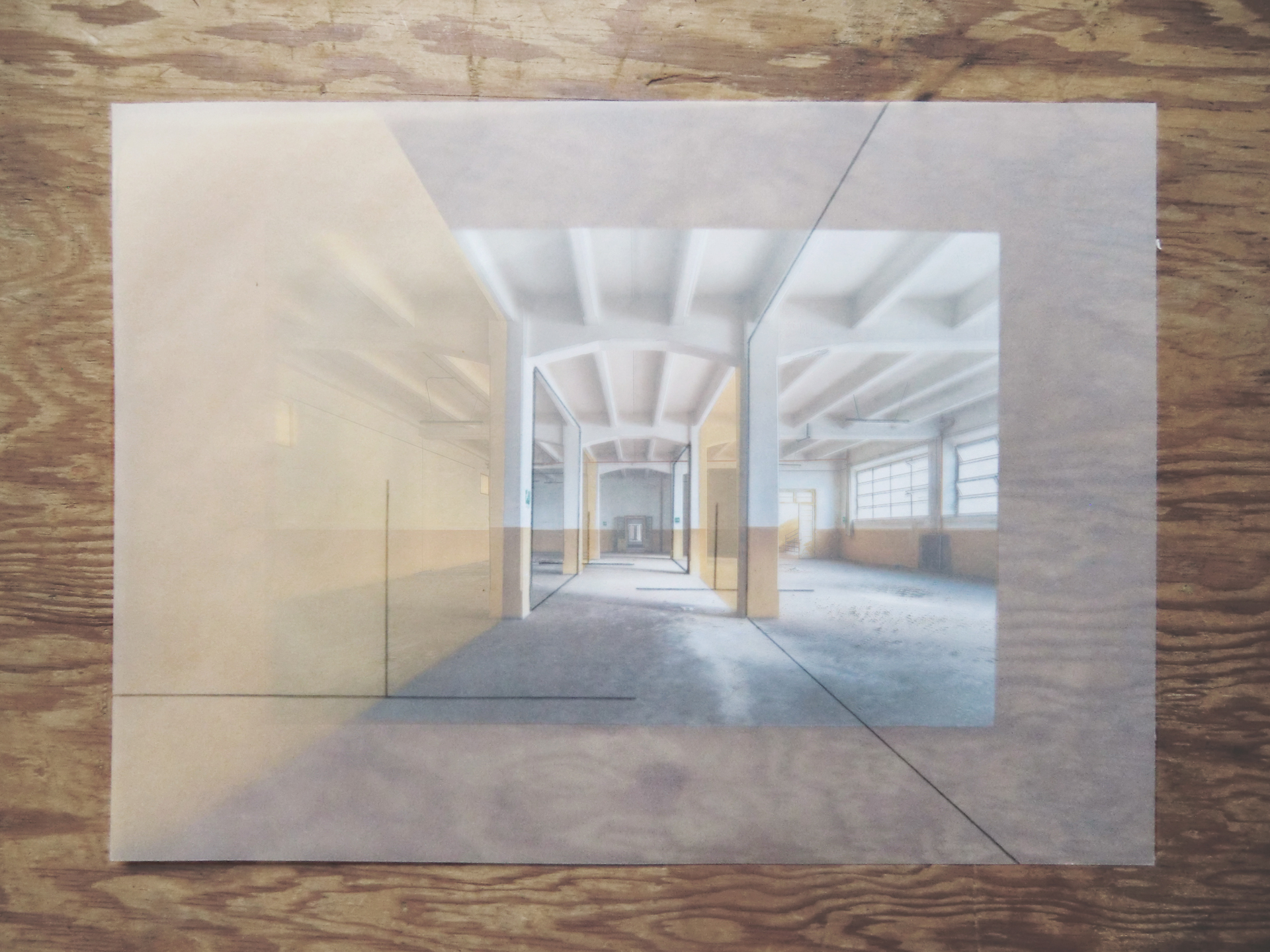
Act 1 – Dividing the space vertically, along with the rhythm of the columns.
Material: Drawing on white and tinted tracing paper.
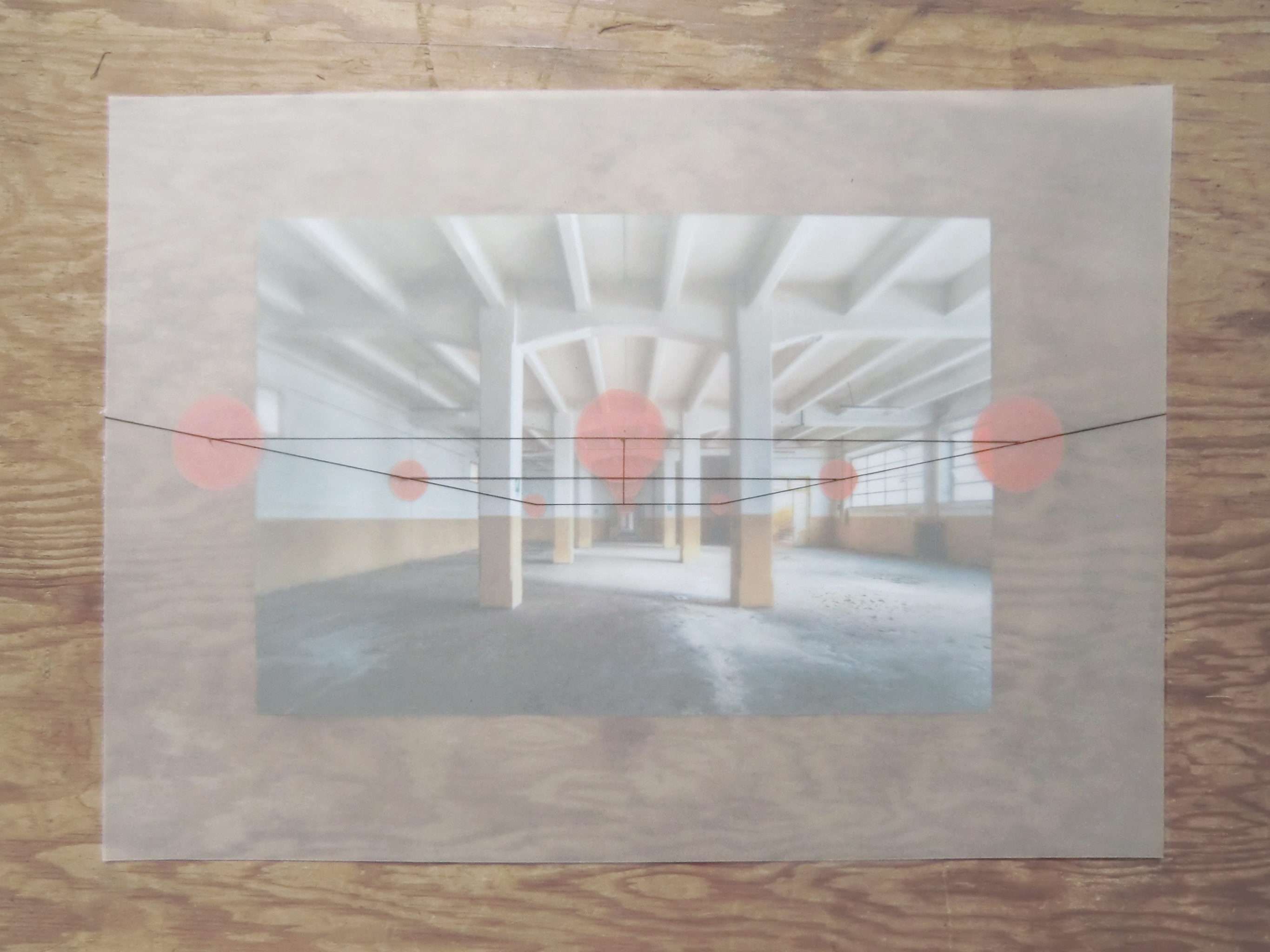
Act 2 – Dividing the space horizontally, with spheres at head height.
Material: Drawing on white and tinted tracing paper.
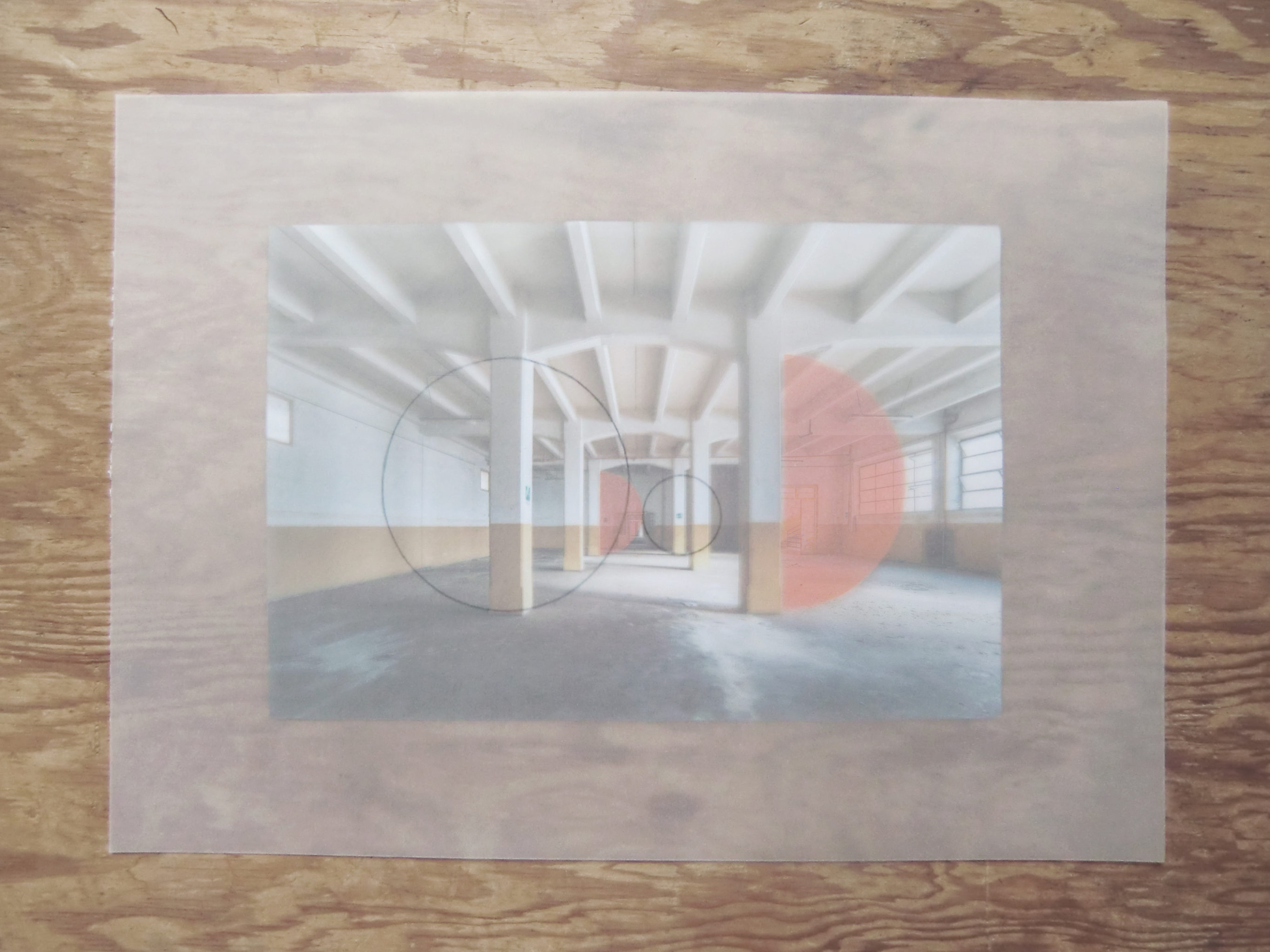
Act 3 – How to divide a circle in a square?
Material: Drawing on white and tinted tracing paper.
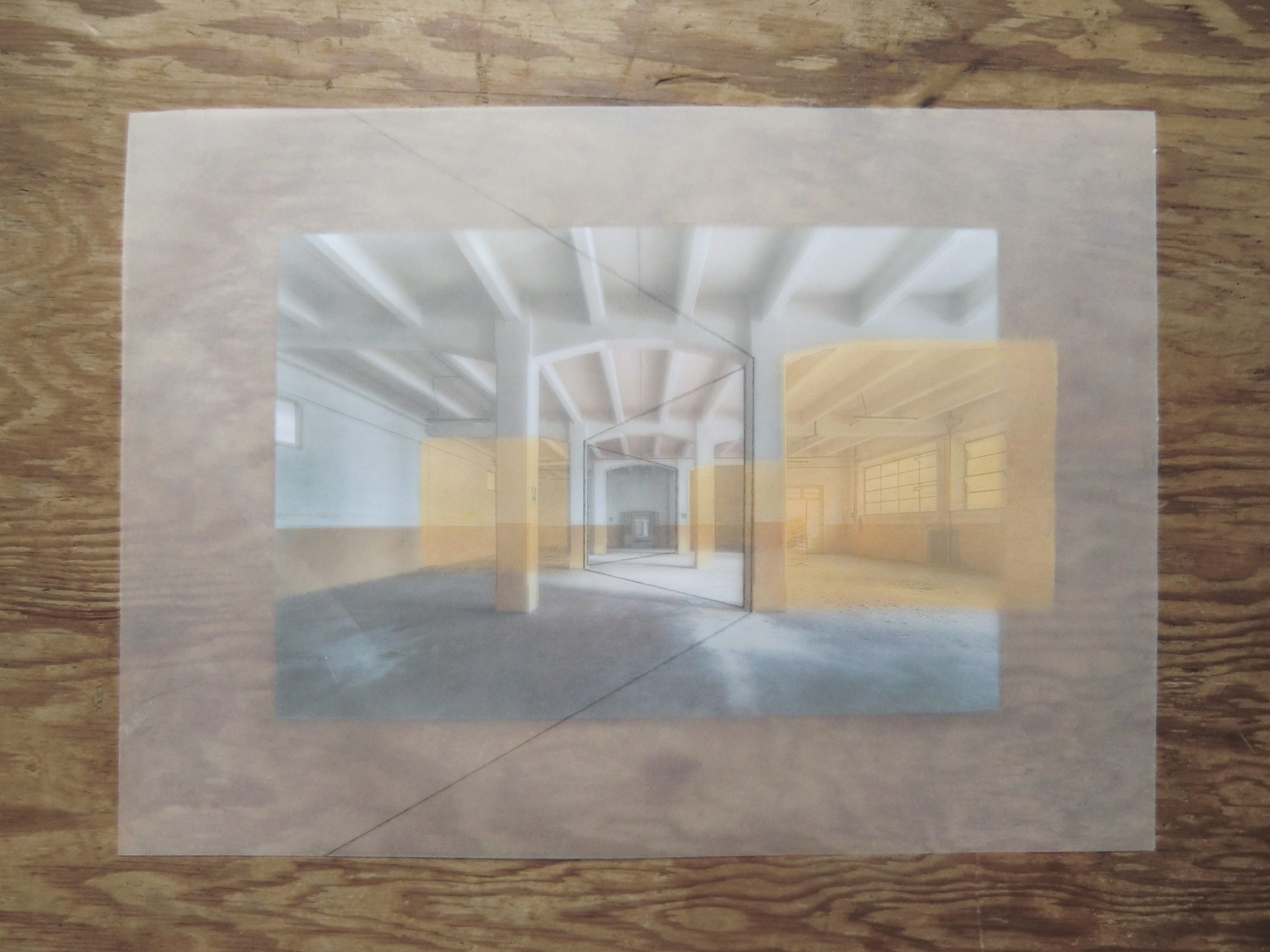
Act 4 – How to not walk in a straight line, in a long and rectangular space?
Material: Drawing on white and tinted tracing paper.
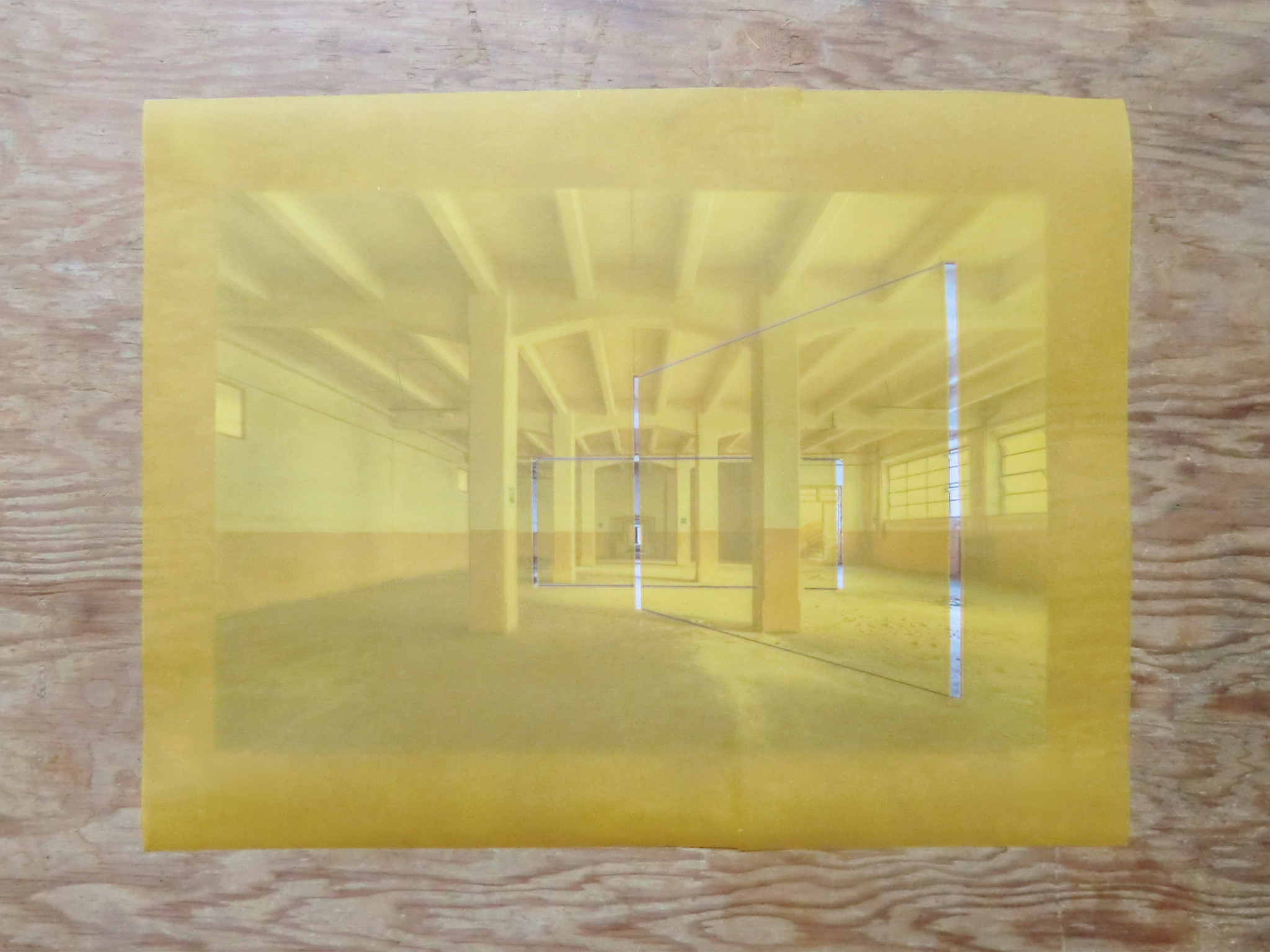
Act 5 – To mess up the existing rhythm of the columns, The rectangle through the rectangles, No rhythm is the new rhythm.
Material: Drawing and cut out on tinted tracing paper.
conversation pieces
Dori Deng & Edoardo Monti
In the form of emailing during the coronavirus lockdown in Italy and UK, 24th to 30th April.
DD:
First thing first, thank you Edo, for having this lockdown-style conversation with me.
I am wondering how are things at Palazzo Monti and with the artist residency programme? Obviously, the residency program had to be paused during the COVID-19. The atmosphere of the space must have undergone a huge change, in contrast with the palazzo’s program that over the past three years was constantly floating with artists’ activities and exhibitions. Do you think the current quietness, or the empty space within the architecture is also inspiring in some ways?
Physical space is always important, but to me now it feels more than ever during this lockdown experience. Personally, I can feel the intensified awareness when interacting with architecture and landscape. Every outdoor physical space seems more ‘concentrated’ with limited time to experience it, I definitely noticed more details about the space than before in the usual days. What about you?
EM:
Thanks again for getting in touch almost three years after coming to Palazzo Monti and for this opportunity. Things have been so far pretty good. We had a chance to slow down a bit, focus on long term projects (creation of an archive that could include all details and portfolios of the over 150 artists that we have so far welcomed to the residency), maintenance, cleaning, fixing, re-organizing our spaces and ultimately installing: we installed all the works we had in storage, because our goal is to have no works in our archive, and have them all installed permanently across the Palazzo.
We sadly had some cancellations from international artist (95% of the artists we welcome and support) for the coming months but we immediately worked on the issue and as of June, when we will be allowed to move more freely across Italy, we will host Italian artists. God knows when planes will fly again, so rather than shutting down we wanted to continue supporting artists so we are focusing more on those shows that can come over. And for sure, I think a quieter city and palazzo have provided for a more calm and tranquil atmosphere for artists to work in. But let’s not forget that these times are extremely stressful for all of us, and artists are some of the most sensitive people in the world. What I constantly tell artists that I am friends with is not to stress too much about having to create more or better works than usual. We are all in tough times, and it’s OK to feel sad and stressed and to not want to create anything for a while. Artists always somehow react to what happens on a social level, but when it’s so unprecedented it’s also OK to have unprecedented reactions.
Ultimately, we are super lucky to have 3 floors and a small courtyard across which we can move freely. I only feel sad thinking of those millions of people confined in small apartments, so myself and the residents are definitely privileged to have so much space to move across. And for sure, we should all reconsider the right to have enough space to live happily in but… to be honest with you, I don’t think this will ever happen on a large scale.
Ah man, so much more to talk about but I hope that these first thoughts gave you some sort of insight into my life. And you? How are you doing? Are you able to access your studio? How do you feel about the future – Yours, of your practice, of our society? What would you change, if anything, from the art world of “before”?
DD:
It is so good to hear from you and the Palazzo! So much has changed in the past three years from my artist residency there, also, much more has changed in the past three months!
I couldn’t agree more with what you mentioned about artists being the most sensitive people to respond to the crisis. I think art is about asking questions most of the time. Good artwork always has the power to provoke something new, or further analyze our perceptive existence. Artists are also constantly questioning throughout their practice, questioning their surroundings. At the moment, our questions expand to much broader fields – structure of the industry, ways of communicating and experiencing, humanity… Most of us are confused and stressed, because these questions are more complicated and bigger than what we can usually feel. As you said, probably most of us are locking down in small confined spaces at the moment. So the irony is that we wonder and ponder about these big questions in small physical spaces, as this seems to be the current reality for a lot of people. And how are we going to respond to it?
As for myself, I have been thinking a lot about my usual way of working site-specifically. Not only just wondering pragmatically how to travel, visit an interesting architectural space and working with it, but much more about the psychological side of our connection to physical architecture or landscape. So much of our memories are held within physical spaces and in this particular period, memory feels very intense and real, whist we literally can’t really travel to places (Not even visit our local restaurants!). I hope this reflection is eventually doing something interesting to my art practice, and to myself, especially now that we have the time and space to question ourselves deep. Luckily, I currently have a whole floor to myself to work in, so this will also become an interesting part of the memory in the future I think.
The sound of archiving works at the palazzo, similarly, is also an action of dealing with memory. An archive is always an interesting act of collecting traces, putting order in the past. What do you hope to achieve with the archive system? The artist residency is so much about the present that archiving the current artists’ activities is actually so interesting! This is turning into your practice as a patron, collector, or archivist! How do you see yourself within this process?
EM:
It’s tough to respond to your first questions because:
a) We are living unprecedented times, which require unprecedented support (psychological as well) from our governments. I think they have too much on their Healthcare System plate to focus on mental health, which is still very much part of this problem but sadly not seen as an emergency. A lot of psychologist and psychiatrists are sharing their knowledge and making themselves available to support, for free, those who are suffering the most and this is amazing!
b) People are different and we all react to pressure in different ways. I wish I could think of a cure-all solution!
c) Spaces, even if all small, are different and only those who live in them really know them. What I mean is that perhaps these many limitations could be turned into an opportunity to create a new body of work or explore a new medium, yet I understand the difficulty of having to deal with different spaces, light, surfaces to work on and with.
We have been extremely privileged in having a large space to spend these 2 months of quarantine. Additionally there were so many things we did to improve the space, in sight of our future residents. The archive will have first of all a strong, visual impact to visitors, that will be able to have an idea of how many artists have been welcomed and supported over the past years. Furthermore, it also works well for us to have a quick access to their works, so that we can present it to visitors in a better way rather than showing a PDF or their instagram accounts. Plus I always loved the idea of a tangible archive, old school style.
I think my role is always changing, while constantly keeping in mind what I was “before”. I see it as a growth rather than a full on change. When people ask me what I do, I can’t give an answer in just a few words. Yes, you may say that I support young artists, but there are so many “roles” played within this main umbrella definition.
I hope all that I am sharing makes sense!
On your end, what do you think were there things that belonged to the Pre-Corona art world that should be changed in a Post-Corona world? Has this worldwide situation, on top of your more personal confinement situation, affected how you see space – private and public?
DD:
In the normal days, everyone had different responsibilities, and we has different roles in many fields. During the lockdown now, a lot of us have temporarily suspended our usual responsibility and our roles, plus we are physically restricted to one location. I definitely think we see things differently and digest information differently too. Things that we didn’t pay attention to, or did not have the time to delve into before; things that we considered irrelevant in the previous ’normal’ life are now on our mind. Like what you mentioned about the awareness of mental health, it is so important for us. Similarly, people are also paying a lot more attention to domestic violence. In a way, I believe extreme events push us to address the issues properly and to make changes. I find it interesting that being ’trapped’ in one location physically makes us see a bigger view and try harder to find a solution.
I recently read about Soren Kierkegaard’s ‘Rotation Method’ theory, where he talks bout limitation when applied to cultivation. It sorts of reflects on us now: “The more a person limits himself, the more resourceful he becomes. A solitary prisoner for life is extremely resourceful; to him a spider can be a source of great amusement.”
I think that is something interesting to share! : )
I am sure we are all seeing, or even currently participating in a lot of digital forms of virtual art activities. A lot of the virtual museum and digital viewing rooms popped up a long time ago, but only now are we pushed to experiment them in full. Like a lot of other industries, the coronavirus pandemic is going to filter out a lot of activities from the past and push towards new ways. However, I don’t think this means that most art activities are going to convert into virtual form- Just the opposite: the next time we create a real physical art experience we will consider and experiment differently. Like what happened 10 years go when the e-book was invented, a lot of people thought that it was the end of printed publication. In reality, it just filtered out a lot of already wasteful print, and we are now putting much more effort in designing printed books. We will definitely be more considerate of what the physical space of a gallery or an art space truly means. More importantly, we will make artwork or exhibitions that take it more into consideration when dealing with the physicality and materiality.
As you said for your role, and the palazzo: there probably wasn’t a sole, defined identity before,and now you are taking the time and space to allow it perhaps to become something even more complex. As for the tangible archive collection you are building at the palazzo, I think it could begin simply with what you liked and why, could there be something deeper subconsciously underlying in the way you considered the space of the palazzo? This is not a question, just my assumption in a way. It doesn’t matter with ‘what it is’ or ‘how it is’, as long as we have these things in mind, deep down…
EM:
Really good input – love what you said about e-book, I had never thought about how in fact the quality of printed content is now higher than ever.
Yes, in regards to the archive, I think we will never forget the value of printed documents and correspondence. Like,can you imagine defining our inbox as archives? A joke. I love hard copies and I wish there could be a sort of Archive of Archives built somewhere, someday. Digitally of course, to make it accessible to anyone the world, but physical too would be so much fun.
And I agree that this crisis will not change what we did before, simply how. We will still look at art in real life, but less than before due to a personal choice (we will become more selective on how we spend our time) and external decisions (travel will be much much much more difficult for months, perhaps years from now). It’s a shame though thinking about the many spaces, private and public, commercial and non-profit, that won’t re-open due to this situation.
Do you have any upcoming projects your are working on? Or any shows that got rescheduled?
DD:
Me too, I love physical copies of books, photographs, even newspapers! Archiving is also my thing, my whole practice is about knitting an archive system of all the experimentations. ‘Archive of Archives’ is an excerllent title for an exhibition, I think you have to make it happen, lol!
I think you are right about the upcoming few years with the travelling restriction. We will, for sure, focus more on our nearby physical surroundings than those afar, but this can be positive for us all. I hope this means you have more time to spend at Palazzo Monti and have new ideas do develop the archive. I will always be watching out for news from the palazzo!
On my side, I am working on developing the project with Manifattura Tabacchi right now. Starting from some imaginative acts, gesture of thoughts in the form of drawings, and we will see if these seeds of ideas can grow into some tangible forms in their space in Florence soon! They have an amazing industrial space to work with. There is also a collaboration with a language artist I have been slowly brewing into a staged performance, and a group exhibition in London. They were all planned for the end of the year, not sure how things will turn out now… We can only take one day at a time these days, aren’t we?!
It has been so fun to speak with you like this via emails! I feel like we could just keep going for a long time. haha…
Dori Deng
(1985)

Dori Deng is a British – Chinese (b.1985) artist living and working in London. Since graduated from Central Saint Martins, Fine Art in 2009, Deng has been developing her practice with the use of projected light in an experimental manner. She uses the ‘notation / score based’ methodology adapted from the 1960-70 contemporary choreography and experimental classical music, to create a unique language and composition of the light and architectural space.
The latest series of light installation Termination Series (2015-present) has been commissioned site-specifically in unique architectural spaces in Italy (Palazzo Galli Tassi, 2018), Beijing (Glass House, C H A O, 2018) and London (Roz Barr Architects, 2016).
The extension to Deng’s used of the light has also been reflected in the collaborations with experimental contemporary classical music. Her understanding of light as a durational medium triggered the collaboration with composers and musicians practice in the forefront of experiemental field today. Recent collaboration projects include sound and light installation and live performance with renowned British composer Laurence Crane, Mica Levi and cellist Oliver Coates.
sito web
«Light has physical structure and duration. To visualise these properties of light I draw connections with architectural spaces organically. The main medium in my practice is projected light, presented through the forms of site-specific and durational installation. Scientifically, we use light to measure the distance to an object by the size of its shadow on the ground. Light is a tool for measuring because of its primary physical properties of propagation direction and intensity. It is a structural, and durational material for us to use throughout the history to acknowledge the architectural space. Light as natural phenomena is mostly seen as a visible static that lands on surfaces (the visible light within human optical acceptance). It is the less visible yet physical qualities of light that fascinate me – the structure and temporality of it. I see light as a time-based, structural medium, it travels with speed and that journey draws a space.
Light becomes a tool to trigger questions: to challenge our perceptive experience of the proportion, and the visual rhythm of a physical space.»
Dori Deng
